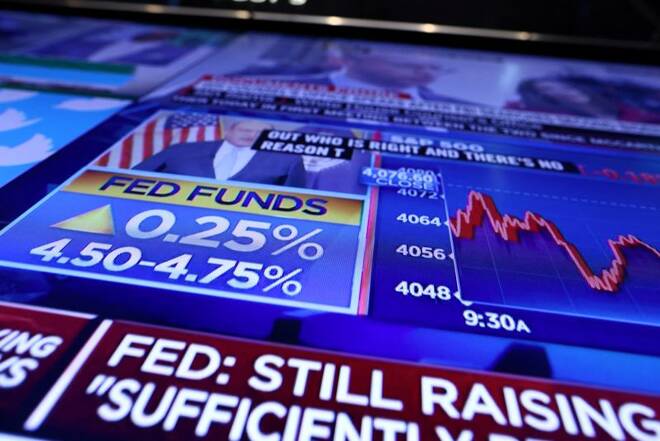Advertisement
Advertisement
Column-Faced down by Fed, markets dab 6% onto risk radar :Mike Dolan
By:
By Mike Dolan LONDON (Reuters) - Market pricing tends to swing back and forth like a pendulum around eventual outcomes - and investors may now have to brace for another tough period working out the amplitude of higher U.S. interest rate possibilities.
By Mike Dolan
LONDON (Reuters) – Market pricing tends to swing back and forth like a pendulum around eventual outcomes – and investors may now have to brace for another tough period working out the amplitude of higher U.S. interest rate possibilities.
Money market guesswork on peak Federal Reserve rates swung back higher this month following surprisingly tight January jobs and inflation readouts. A once almost outlandish 6% top now seems to have crept onto the edge of the risk radar.
A Fed policy rate peak at 6% – more than 150 basis points higher than the current target and 75bp above standing futures market assumptions of the terminal rate – is still far from consensus that is now firmly in line with the central bank’s own central assumption of 5.0-5.25%.
But most of those forecasters admit the balance of risks on their outlook for peak rates is now tilted even higher, and for traders who had pencilled in a terminal rate of less than 2%little over a year ago, the full gamut of possibilities is now being entertained.
A combination of January’s jobs and inflation numbers has at least stopped markets undershooting the Fed’s ‘dot plot’ guidance, following months in which futures doubted both the need and willingness to follow through with tightening to that extent.
It’s been a sobering couple of weeks.
Markets now tally with a 5.25% peak and, just as significantly, see rates still above 5% by year-end – at least one rate rise higher than current levels.
Two-year Treasury yields hit their highest in three months at 4.65%, now on par with the current Fed policy rate.
Any thought of credit easing anytime soon from where it is today – so central to the early-year market optimism – is being taken off the table bit by bit.
As 2023 recession risks recede, Fed policymakers talk tough and one of the few remaining dovish board members – Vice Chair Lael Brainard – exits the council, there’s been seismic change in tone at least.
Glenmede chief investment officer Jason Pride said the inflation update dented the “immaculate disinflation” narrative.
Morgan Stanley’s Matthew Hornbach described the payrolls as a “mood changing” print that’s seen markets chase rates higher as if gripped by a sort of reverse FOMO – fear of missing out.
Only last week, JPMorgan boss Jamie Dimon warned that the Fed could lift rates above the 5% mark if inflation stayed “sticky”. “People should take a deep breath on this one before they declare victory,” he said.
And some traders appear to be inhaling very large gulps of air.
Reports circulated last week of swaps and options market activity on the Chicago Mercantile Exchange that bet on market rates touching 6%, or at least hedging against that possibility.
The pendulum, it seems, has swung back to the other extreme.
Six appeal
For many Cassandra-like analysts who’ve been wary of outsize Fed rate rises for over a year, this makes some sense and the re-pricing may well have even further to go.
Societe Generale’s quantitative analyst Olivier Tadesse has modelled an overall level of tightening he thinks the Fed will need to do to sap this bout of inflation – combining the impact of rate rises and quantitative tightening (QT) via the rundown of its balance sheet of bonds.
The gist of Tadesse’s original analysis last year was that some 900bp of overall Fed tightening would be necessary to get inflation back to target, half from a massive $3.9 trillion of QT and the remainder from 450bp of rate hikes.
But if the extent of the Fed’s balance sheet reduction remains at the current $95 billion per month and totals a more modest $2.5 trillion over the cycle, he argues the policy rate may have to go much higher – possibly as high as 6.5%.
So why haven’t stock markets run scared?
Part of it is simply because most funds remain underweight equity after a torrid 2022.
But mostly it’s because the majority of investors simply don’t believe that uber-hawkish possibility.
Bank of America’s latest monthly survey of fund managers around the world showed less than 5% of respondents expect peak rates above 5.5% – with the majority on consensus around 5.25%.
Amundi Institute chief Monica Defend says their economic modelling tested 6% peak Fed rate and showed extensive damage to the real economy and a likely recession, but much less traction in getting inflation back to target.
Because of that asymmetric impact, she reckons the Fed “won’t risk it” and agrees with the current assumptions that the top is 5.25%.
If that’s true, the battle over the terminal rate may now be overtaken by how long the Fed can keep rates higher to achieve its goals. And depending on how the underlying economy copes, that could cast a pall over 2024 as much as this year as the prospects of fresh easing disappear over the horizon.
The opinions expressed here are those of the author, a columnist for Reuters.
(by Mike Dolan, Twitter: @reutersMikeD; ; editing by John Stonestreet)
About the Author
Reuterscontributor
Reuters, the news and media division of Thomson Reuters, is the world’s largest international multimedia news provider reaching more than one billion people every day. Reuters provides trusted business, financial, national, and international news to professionals via Thomson Reuters desktops, the world's media organizations, and directly to consumers at Reuters.com and via Reuters TV. Learn more about Thomson Reuters products:
Latest news and analysis
Advertisement
